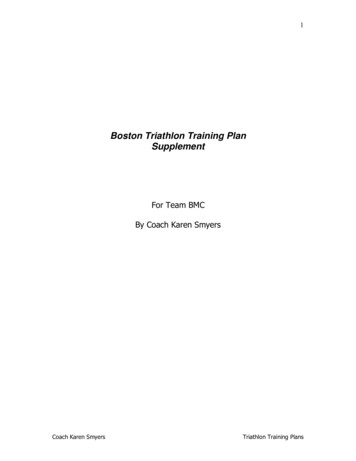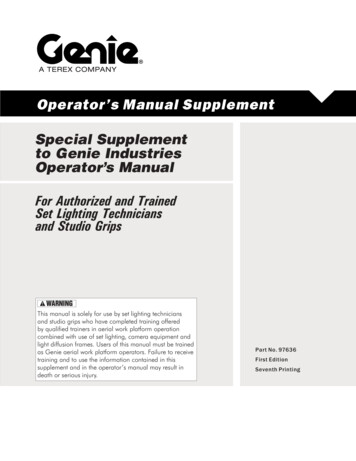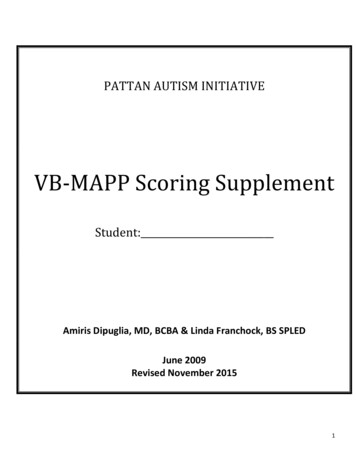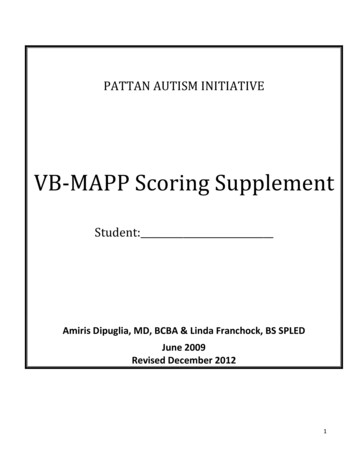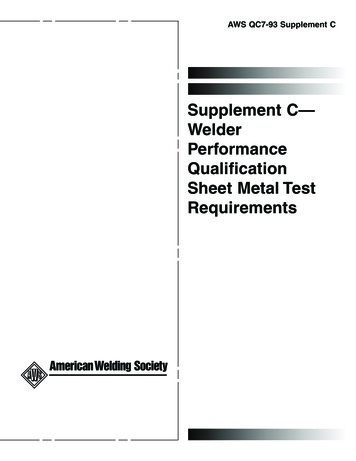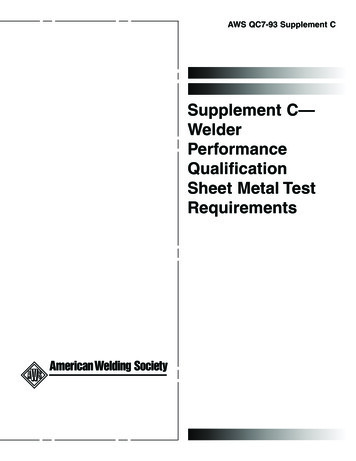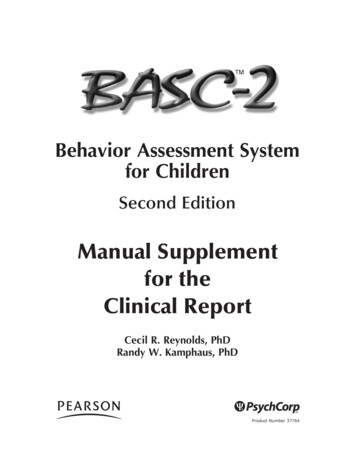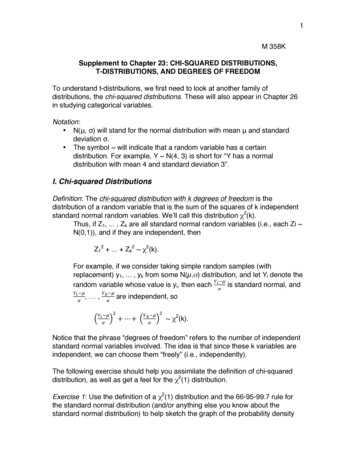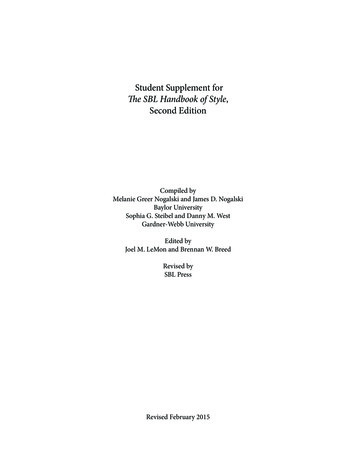
Transcription
Student Supplement forThe SBL Handbook of Style,Second EditionCompiled byMelanie Greer Nogalski and James D. NogalskiBaylor UniversitySophia G. Steibel and Danny M. WestGardner-Webb UniversityEdited byJoel M. LeMon and Brennan W. BreedRevised bySBL PressRevised February 2015
CONTENTSPart 1: Citation and Transliteration Guidelines for Term Papers1.1. Getting Started1.2. Biblical Citations1.3 Working with Biblical Commentaries1.3.1. Series Title and Volume Title1.3.2. Numbered Series or Nonnumbered Series1.3.3. Multivolume Commentaries1.3.4. Single-Volume Commentaries on the Entire Bible1.3.5. Series with New Numbers1.4. Bible Dictionaries and Encyclopedias1.5. Abbreviations1.6. Citations of Electronic Sources1.7. Transliterating Greek and Hebrew WordsPart 2: Formatting Guidelines for Term Papers2.1. Margins2.2. Spacing2.3. Pagination2.4. Text Format2.5. Paragraph Indentation2.6. Headings and Subheadings2.7. Contents Page2.8. Title Page2.9. Footnotes2.10. Biblical References2.11. Bibliography2.12. Citing Publisher and Place NamesPart 3: Samples3.1.3.2.3.3.3.4.3.5.Title PageContents (For Term Papers)HeadingsAppendixesBibliography
PART 1. CITATION AND TRANSLITERATION GUIDELINES FOR TERM PAPERS1.1. Getting StartedThe text of this supplement is formatted to match the style of SBLHS; thus it follows book style asopposed to term-paper style. All the samples in part 3 of this supplement follow the term-paperstyle.Citing works properly is an important component of writing a term paper. Become familiarwith the styles for notes and bibliographies illustrated in the second edition of The SBL Handbookof Style (SBLHS). These general (SBLHS 6.2–3) and special (6.3) examples have been chosen withcare to cover the broadest array of resources. SBLHS provides sample entries for the initial citationof a work in a footnote, subsequent citations of the same work, and the entry for the bibliographyat the end of the paper.When conducting research, check the title page of a source and carefully record all pertinentbibliographic information. Frustrations arise when students are preparing manuscripts and realizethat they are missing key pieces of information. In addition to the author and title of the work,students should record the editor, translator, number of volumes, edition, series, city, publisher,and date.The following material will address problems students typically encounter when working withbiblical texts and secondary literature. These illustrations will help students avoid many problems,but they do not replace the need to become familiar with the examples provided in SBLHS.1.2. Biblical CitationsCitations of modern Bible versions do not require publisher’s information in either footnotes orbibliography; instead, use the standard abbreviation for the Bible version (e.g., NRSV, RSV, NIV,NASB; see SBLHS 8.2). If citing scripture from a single version, include the abbreviation of theversion following the chapter and verse on the first scripture reference only. When citing more thanone version in a paper, include the version after each citation.“Now Ahab had seventy sons in Samaria” (2 Kgs 10:1 NRSV).When citing specific chapters or chapters and verses, use the standard abbreviated titles of biblicalbooks provided in SBLHS 8.3.1–3. If, however, a biblical book is the first word of the sentence, donot abbreviate it. In addition, when referring to the book as a whole or a person with the same nameas a biblical book, do not abbreviate it.1
2Correct:Revelation 3 begins with the letter to the church in Sardis.We know little about the historical Habakkuk.Incorrect:Rev 3 begins with the letter to the church in Sardis.We know little about the historical Hab.Cite biblical verses with chapter and verse(s) using arabic numerals separated by a colon. Donot write out the numbers. When referencing consecutive verses, separate the first and last versenumbers with an en dash, not a hyphen (see SBLHS 2.1.3.4).Correct:John 5:8–9Incorrect:John chapter five verses eight and nine.John 5:8-9When citing multiple passages, list the abbreviated title of each new biblical book followed bythe chapter number and colon, with all verses in that chapter separated by a comma and space.A semicolon should separate references to subsequent chapters or books. Do not include theconjunction “and” or an ampersand before the last citation. List passages in canonical and numericalorder.Correct:Matt 2:3; 3:4–6; 4:3, 7; Luke 3:6, 8; 12:2, 5; Acts 15:1–5; Rom 1:8–12Incorrect:Luke 3:6, 8; Luke 12:2Matt 2:3, 3:4–6; 4:3; Luke 3:6, 8 and 12:2Rom 1:8–12; Matt 2:3; 4:3, 7; 3:4–6Further examples of correct and incorrect citations are listed in SBLHS 8.2.In study Bibles such as The HarperCollins Study Bible or The New Oxford Annotated Bible, specialarticles and the notes (usually at the bottom of the page) are not part of the biblical text. Study notesare written by authors or editors whose names are included in the front matter of the study Bible. Ifthese notes are cited, all the relevant information from the specific study Bible should be included.3. David L. Petersen, “Ezekiel,” in The HarperCollins Study Bible Fully Revised andUpdated: New Revised Standard Version, with the Apocryphal/Deuterocanonical Books, ed.Harold W. Attridge et al. (San Francisco: HarperSanFrancisco, 2006), 1096.5. Petersen, “Ezekiel,” 1096.Petersen, David L. “Ezekiel.” Pages 1096-1167 in The HarperCollins Study Bible Fully Revisedand Updated, New Revised Standard Version, with the Apocryphal/DeuterocanonicalBooks. Edited by Harold W. Attridge et al. San Francisco: HarperSanFrancisco, 2006.
31.3. Working with Biblical Commentaries1.3.1. Series Title and Volume TitleMost biblical commentaries appear as part of a commentary series, the purpose of which is tocomment upon the biblical text using the same general format. When working with a single volumein a commentary series, follow the citation guidelines for “A Work in a Series” (SBLHS 6.2.24). Mostcommentary series are listed in the abbreviations found in SBLHS 8.4.1–2.When collecting bibliographic information, distinguish carefully between the volume title andthe series title. Whether abbreviated or written in full, volume titles are italicized, but series titlesare not.18. Claus Westermann, Genesis 12–36, trans. John J. Scullion, CC (Minneapolis: Fortress,1995), 25.20. Westermann, Genesis 12–36, 44.Westermann, Claus. Genesis 12–36. Translated by John J. Scullion. ContinentalCommentaries. Minneapolis: Fortress, 1995.1.3.2. Numbered Series or Nonnumbered SeriesThe publishers of some biblical commentaries number each volume in the series, while others donot. If the series uses numbers (e.g., Anchor Bible or Word Biblical Commentary), the number goesimmediately after the name of the series but does not include the word “volume” or its abbreviation.1.3.3 Multivolume Commentaries1.3.3.1. Multivolume Commentaries on a Single Biblical Book by One Author. Usually each volumehas a separate title for the books and chapters treated in a given volume, as in Wenham’s twovolume commentary on Genesis in the Word Biblical Commentary. The title of one volume isGenesis 1–15, and the other is Genesis 16–50. In other cases each volume uses the same title andis distinguished only by volume number, using either roman or arabic numerals. The followingexample of Dahood’s three-volume Psalms commentary is taken from SBLHS 7.3.10.If the paper references all three volumes, cite the entire multivolume work.4. Mitchell Dahood, Psalms, 3 vols., AB 16–17A (Garden City, N.Y.: Doubleday, 1965–1970), 3:127.7. Dahood, Psalms, 2:121.Dahood, Mitchell. Psalms. 3 vols. AB 16–17A. Garden City, N.Y.: Doubleday, 1965–1970.
4If the paper refers to only one or two of the three volumes, cite each volume individually.78. Mitchell Dahood, Psalms I: 1–50, AB 16 (Garden City, NY: Doubleday, 1965), 44.79. Dahood, Psalms I: 1–50, 78.82. Mitchell Dahood, Psalms II: 51–100, AB 17 (Garden City, NY: Doubleday, 1968), 347.86. Dahood, Psalms II: 51–100, 351.Dahood, Mitchell. Psalms I: 1–50. Vol. 1 of Psalms. AB 16. Garden City, NY: Doubleday,1965.———. Psalms II: 51–100. Vol. 2 of Psalms. AB 17. Garden City, N.Y.: Doubleday, 1968.1.3.3.2. Multivolume Commentaries for the Entire Bible by Multiple Authors. To save space,multivolume commentaries often combine treatments of multiple biblical books into a singlevolume. A different author usually writes the commentary on each biblical book. In this case, treateach author’s commentary like a chapter in a book written by several authors (SBLHS 6.2.23).Multivolume commentaries cited in a footnote should use the abbreviated title listed in SBLHS8.4.1–2. The author of the section should still be cited. The bibliographical entry may provide thecomplete title and publication information of the larger work or use the abbreviated title, as in thefinal example below.1. Patrick D. Miller, NIB 6:577.Miller, Patrick D. “The Book of Jeremiah: Introduction, Commentary, and Reflections.”Pages 553–926 in Introduction to Prophetic Literature, Isaiah, Jeremiah, Baruch, Letter ofJeremiah, Lamentations, Ezekiel. Vol. 6 of New Interpreter’s Bible. Edited by Leander E.Keck. Nashville: Abingdon, 2001.Miller, Patrick D. “The Book of Jeremiah: Introduction, Commentary, and Reflections.” NIB6:553–926.1.3.4 Single-Volume Commentaries on the Entire BibleCheck the resource carefully. Some single-volume commentaries are authored by one individualand are thus cited like any other monograph. Others are edited volumes where more than oneperson has written the commentary on individual books. In these cases, cite the author of thatsection of the commentary as you would the chapter in a book with an editor (SBLHS 6.2.12).5. Jack G. Partain, “Numbers,” in Mercer Commentary on the Bible, ed. Watson E. Millset al. (Macon, GA: Mercer University Press, 1995), 175–79.
58. Partain, “Numbers,” 175.Partain, Jack G. “Numbers.” Pages 175–79 in Mercer Commentary on the Bible. Edited byWatson E. Mills et al. Macon, GA: Mercer University Press, 1995.1.3.5. Series with New NumbersOccasionally a publisher will restart the numbering of a book series or a journal. When thishappens, include the number of the new series, separated from the volume number by a forwardslash as illustrated in SBLHS 6.2.24.1.4. Bible Dictionaries and EncyclopediasCite the author of the article, not the editor of the work as a whole (SBLHS 6.3.6). Most Bibledictionaries and encyclopedias put the author’s name at the end of the article that he or she wrote.If multiple articles from the same source are used, cite the author and article individually in thefootnotes. The bibliographical entry may provide the complete title and publication information ofthe larger work or use the abbreviated title, as in the final example below.1. Stanley D. Walters, “Jacob Narrative,” ABD 3:599–609.Walters, Stanley D. “Jacob Narrative.” Pages 359–609 in vol. 3 of The Anchor Bible Dictionary.Edited by David Noel Freedman. 6 vols. New York: Doubleday, 1992.Walters, Stanley D. “Jacob Narrative.” ABD 3:359–609.When multiple articles from the same dictionary or encyclopedia have been used, list the workas a whole under the editor in the bibliography, but cite the individual authors and articles in thefooonote as above.Freedman, David Noel, ed. The Anchor Bible Dictionary. 6 vols. New York: Doubleday, 1992.1.5. AbbreviationsAbbreviate titles of journals and book series both in footnotes and in the bibliography; provide afull reference for a reference work such as BAGD in the bibliography.The SBL Handbook of Style offers two extensive lists of abbreviations for journals, series, andother standard reference works. The first abbreviation list is alphabetized by source (SBLHS 8.4.1)and the second by abbreviation (SBLHS 8.4.2). If the work you are citing is in these lists, use thestandard abbreviation listed.Note that both lists italicize abbreviations of journal titles and abbreviations based on booktitles (e.g., JBL, COS) but do not italicize the abbreviations of book series (e.g., WGRW, JSOTSup)or abbreviations based on personal names (e.g., BAGD, BDB).
6If a work is not included in the abbreviation lists of SBLHS or some other authoritative resource(e.g., IATG, CAD), use complete titles throughout or include a list of additional abbreviations on aseparate page at the beginning of the paper (after the title page and before the main text).1.6. Citations of Electronic SourcesAs Internet-based publications play a growing role in scholarly discourse, students must familiarizethemselves with citation guidelines for electronic sources. Students should consult the detailedinstructions for documenting CD-ROM and Internet resources in SBLHS 6.1.6, 6.3.10, 6.4.12–15.List electronic sources by the author’s name, and enclose the title of the webpage in quotationmarks, as you would a journal article. Since pagination will change from printer to printer, do notcite page numbers for online resources. Since many websites change their content frequently, try toinclude the date the resource was published on the website; SBLHS discourages including the datethe student last accessed the page (see 6.1.6).7. R. Timothy McLay, “The Goal of Teaching Biblical and Religious Studies in theContext of an Undergraduate Education,” SBL Forum, 6 October 2006, articleId 581.9. McLay, “The Goal of Teaching.”McLay, R. Timothy. “The Goal of Teaching Biblical and Religious Studies in the Contextof an Undergraduate Education.” SBL Forum, 6 October 2006. articleId 581.1.7. Transliterating Greek and Hebrew Words If a student has training in biblical languages, it is preferable to use a Greek or Hebrewfont when discussing particular words. When citing Hebrew, use only the consonantaltext unless the vowel pointing is necessary for the argument. The SBL Handbook of Style provides two different translitera
slash as illustrated in SBLHS 6.2.24. 1.4. Bible Dictionaries and Encyclopedias Cite the author of the article, not the editor of the work as a whole (SBLHS 6.3.6). Most Bible dictionaries and encyclopedias put the author’s name at the end of the article that he or she wrote. If multiple articles from the same source are used, cite the author and article individually in the footnotes. The .

